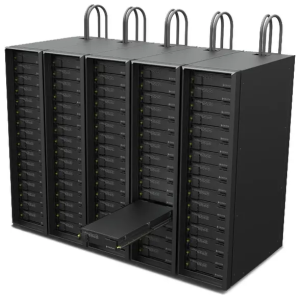
Attributed to Jason Low, Regional Head of APAC, Iceotope
Malaysia is swiftly emerging as a data centre powerhouse in Southeast Asia, driven by the growing demand for cloud computing and artificial intelligence (AI). Tech giants such as Google, Nvidia, and Microsoft are investing billions of dollars to establish and expand data centres in the region. Last year, the Minister of Trade announced that data centre-related investments have totalled MYR 76B (USD 16B).
Several factors contribute to Malaysia’s attractiveness in the global data centre market: proactive investor facilitation, cost-efficiency, a large landbank and seamless connectivity to Asia and beyond through 22 submarine cable networks and 14 landing stations.

Jason Low, Regional Head of APAC, Iceotope
Growing pains
Data centres are important enablers of the digital economy, processing vast amounts of data and supporting global business operations. However, as the number of data centres grows, so does the challenge of managing the immense heat they generate. In tropical Malaysia, which continues to battle a scorching heat wave, the pressure to keep this multi-billion dollar hub cool is rising.
Data centres consume enormous amounts of energy and other natural resources, and in the rapidly developing region, the demand is swelling. Potential electricity demand from data centres in Malaysia is estimated to hit over 5,000 megawatts by 2035, according to the national electricity company Tenaga Nasional Berhad (TNB).
Earlier this year, Malaysia’s main water regulator, the National Water Services Commission, cautioned that the country could face widespread water shortages in the next five years due to climate change, wastage and ageing infrastructure. Experts also noted similar sentiments, noting that existing and planned data centres are also concentrated in areas like the Klang Valley and Johor which have grappled with water supply shortages for decades.
Meeting Malaysia’s sustainability goals
Precision Liquid Cooling offers cutting-edge technology for cooling high-performance computing systems, such as servers and data centres. It offers exceptional thermal stability through the precise delivery of dielectric fluid across the entire IT stack. It removes nearly 100% of the heat generated and reduces energy use by up to 40% and water consumption by up to 100%. There are no performance-throttling hotspots, no front-to-back air cooling, no bottom-to-top immersion constraints, and no physical space wasted on unnecessary air cooling infrastructure.

Precision Liquid Cooling offers exceptional sustainability by minimising water consumption and significantly reducing carbon emissions. This approach recaptures nearly 100% of the heat generated, allowing for efficient reuse and supporting green data centre initiatives. By effectively capturing nearly 100% of the heat produced by servers, these solutions also minimise water usage due to reduced mechanical cooling requirements. In doing so, data centres can also see a reduction in water costs, particularly notable as Malaysia increased its water tariff rates for the first time in decades earlier this year.
Precision Liquid Cooling is designed to integrate seamlessly into current data centre infrastructure, making it a versatile solution for modern data centres. It also reduces stress on chassis components, reducing component failures by 30% and extending server lifecycles. The ability to hot swap servers both within data centres and remote locations streamlines service calls, eliminating exposure to inclement environmental elements and substantially reducing the risks associated with service operations.
As Malaysia gears up for the immense opportunities that come with these multi-billion dollar investments, it will also have to face various sustainability challenges and anticipated regulatory pressures to reduce carbon footprints. In an era where environmental sustainability and operational efficiency are critical, embracing Precision Liquid Cooling can help Malaysia’s data centres thrive while mitigating their environmental impact. As Malaysia sets its sights on Net Zero 2050 and its continued ambitions towards becoming a self-sufficient industrialised nation, the onus is on corporations, regulatory bodies and technology solution providers alike to keep them on track.
 (0)
(0) (0)
(0)Archive
- October 2024(44)
- September 2024(94)
- August 2024(100)
- July 2024(99)
- June 2024(126)
- May 2024(155)
- April 2024(123)
- March 2024(112)
- February 2024(109)
- January 2024(95)
- December 2023(56)
- November 2023(86)
- October 2023(97)
- September 2023(89)
- August 2023(101)
- July 2023(104)
- June 2023(113)
- May 2023(103)
- April 2023(93)
- March 2023(129)
- February 2023(77)
- January 2023(91)
- December 2022(90)
- November 2022(125)
- October 2022(117)
- September 2022(137)
- August 2022(119)
- July 2022(99)
- June 2022(128)
- May 2022(112)
- April 2022(108)
- March 2022(121)
- February 2022(93)
- January 2022(110)
- December 2021(92)
- November 2021(107)
- October 2021(101)
- September 2021(81)
- August 2021(74)
- July 2021(78)
- June 2021(92)
- May 2021(67)
- April 2021(79)
- March 2021(79)
- February 2021(58)
- January 2021(55)
- December 2020(56)
- November 2020(59)
- October 2020(78)
- September 2020(72)
- August 2020(64)
- July 2020(71)
- June 2020(74)
- May 2020(50)
- April 2020(71)
- March 2020(71)
- February 2020(58)
- January 2020(62)
- December 2019(57)
- November 2019(64)
- October 2019(25)
- September 2019(24)
- August 2019(14)
- July 2019(23)
- June 2019(54)
- May 2019(82)
- April 2019(76)
- March 2019(71)
- February 2019(67)
- January 2019(75)
- December 2018(44)
- November 2018(47)
- October 2018(74)
- September 2018(54)
- August 2018(61)
- July 2018(72)
- June 2018(62)
- May 2018(62)
- April 2018(73)
- March 2018(76)
- February 2018(8)
- January 2018(7)
- December 2017(6)
- November 2017(8)
- October 2017(3)
- September 2017(4)
- August 2017(4)
- July 2017(2)
- June 2017(5)
- May 2017(6)
- April 2017(11)
- March 2017(8)
- February 2017(16)
- January 2017(10)
- December 2016(12)
- November 2016(20)
- October 2016(7)
- September 2016(102)
- August 2016(168)
- July 2016(141)
- June 2016(149)
- May 2016(117)
- April 2016(59)
- March 2016(85)
- February 2016(153)
- December 2015(150)
